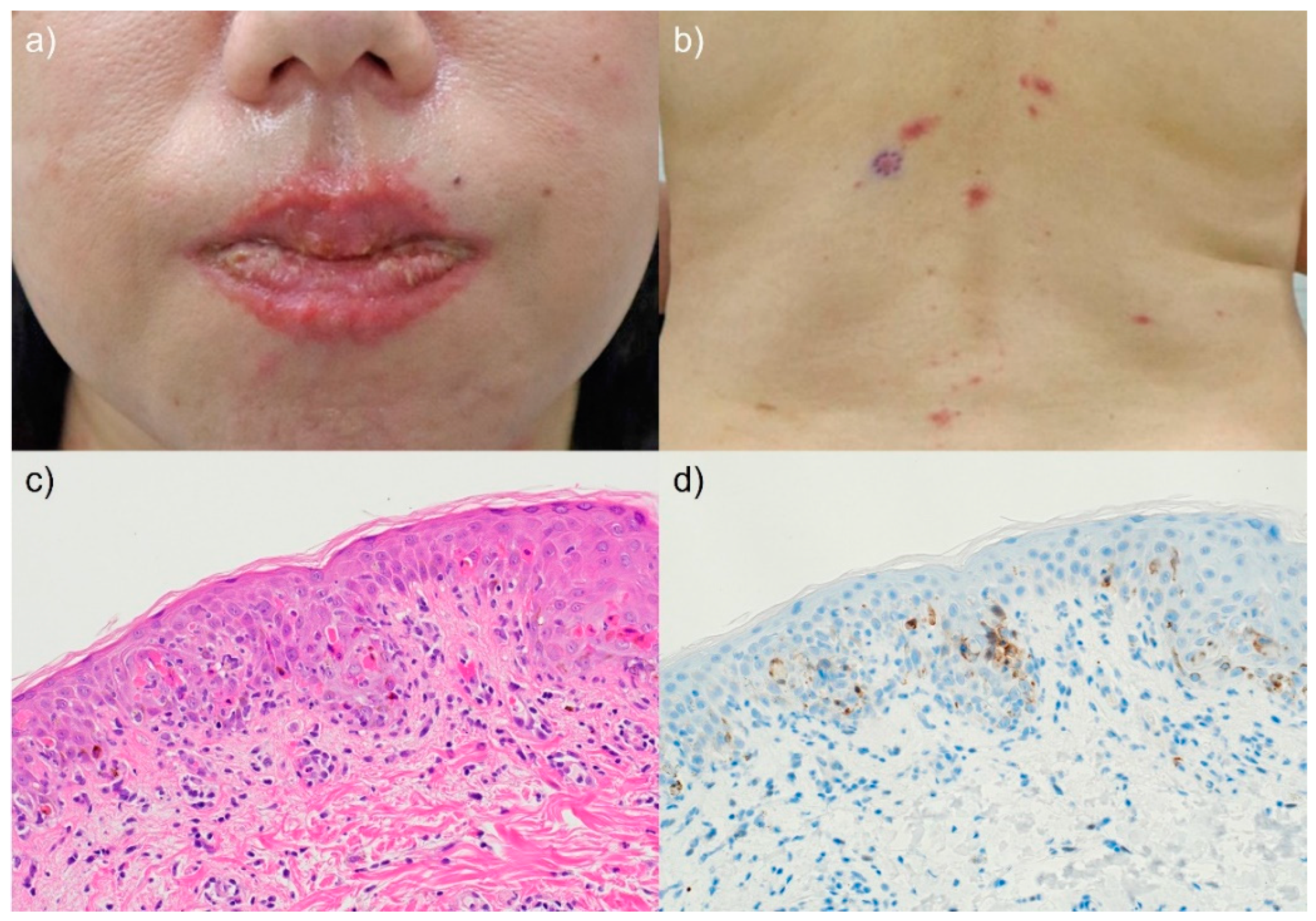The patient was a 44-year-old woman with suspected Stevens-Johnson syndrome due to Baktar® (sulfamethoxazole trimethoprim) medication received at our outpatient dermatology clinic.
The patient presented with sores on her lips and mouth (
Figure 1a) and erythema of the whole body (mainly on the palms and soles). A 5 mm dermal punch biopsy was taken from erythema on the dorsal surface of her back (
Figure 1b). Histopathological examination of the epidermis, dermis, and subcutaneous adipose tissue samples showed numerous necrotic keratinocytes in the epidermis (
Figure 1c). Apoptotic nuclei were visualized as diaminobenzidine brown deposits with immunoperoxidase staining for cleaved caspase-3 by using a 1:500-diluted rabbit polyclonal antibody available from Cell Signaling Technology (Danvers, MA, USA) as was described earlier [
1]. Cleaved-caspase3-positive findings were consistent with eosinophilic material that appeared to be necrotic cells within the epidermis (
Figure 1d). Therefore, these eosinophilic materials must be apoptotic bodies. Generally speaking, and especially in Japan, these materials are considered necrotic keratinocytes [
2]. However,
McKee’s Pathology of the Skin and
Weedon’s Skin Pathology[
3,
4] show these materials as apoptotic keratinocytes. To our best knowledge, no studies have used apoptotic immunohistochemical markers to examine whether these structures are apoptotic.
2,3,4 As reported previously, necrotic keratinocytes can also be a possibility. Further multicenter studies with a more significant number of cases are warranted.
Author Contributions
Conceptualization, M.T.; methodology, M.T.; validation, M.T., H.H., and K.T.; investigation, M.T., and H.H.; resources, K.T., and Y.K.; data curation, M.T.; writing—original draft preparation, M.T.; writing—review and editing, H.H. and Y.K.; supervision, Y.K.; project administration, Y.K. All authors have read and agreed to the published version of the manuscript.
Funding
This research received no external funding.
Institutional Review Board Statement
Not applicable.
Informed Consent Statement
Informed consent was obtained from all subjects involved in the study. The patient has written informed consent.
Data Availability Statement
Data is unavailable.
Acknowledgments
The authors would like to thank Mr. Naoki Ooishi, Mr. Kuniaki Muramatsu, and Mr. Takayoshi Hirota, (Division of Pathology and Oral Pathology, Shimada General Medical Center, Shimada, Shizuoka, Japan), for their technical assistance, and Prof. Tina Tajima for editing our English manuscript.
Conflicts of Interest
The authors declare no conflict of interest.
References
- Tsutsumi, Y.; Kamoshida, S. Pitfalls and caveats in histochemically demonstrating apoptosis. Acta Histochem Cytochem 2003, 36, 271–280. [Google Scholar] [CrossRef]
- Fujii, M.; Takahashi, I.; Kishiyama, K.; Honma, M.; Ishida-Yamamoto, A. Erythema multiforme-type drug eruption with prominent keratinocyte necrosis induced by long-term administration of telmisartan. J Dermatol 2015, 42, 537–539. [Google Scholar] [CrossRef] [PubMed]
- Patterson, J.W. Weedon’s Skin Pathology., 5th ed.; ELSEVIER: Amsterdam, Netherlands, 2021; pp.54, 64, 67,72. [Google Scholar]
- Calonje, E.; Brenn, T.; Lazar, A.J.; Billings, S.D. McKee’s Pathology of the Skin with Clinical Correlations., 5th ed.; ELSEVIER: Amsterdam, Netherlands, 2020; p. 264. [Google Scholar]
|
Disclaimer/Publisher’s Note: The statements, opinions and data contained in all publications are solely those of the individual author(s) and contributor(s) and not of MDPI and/or the editor(s). MDPI and/or the editor(s) disclaim responsibility for any injury to people or property resulting from any ideas, methods, instructions or products referred to in the content. |
© 2023 by the authors. Licensee MDPI, Basel, Switzerland. This article is an open access article distributed under the terms and conditions of the Creative Commons Attribution (CC BY) license (http://creativecommons.org/licenses/by/4.0/).





